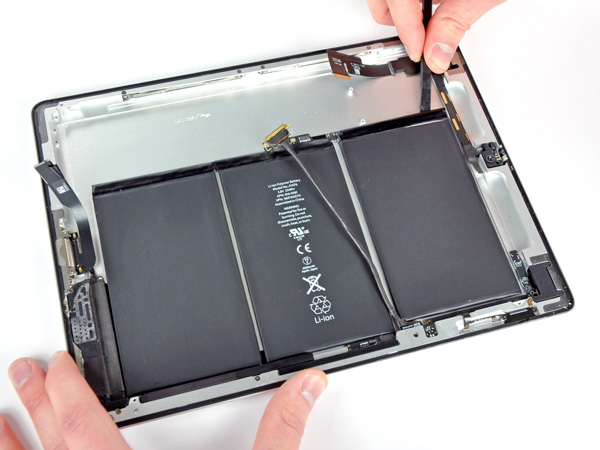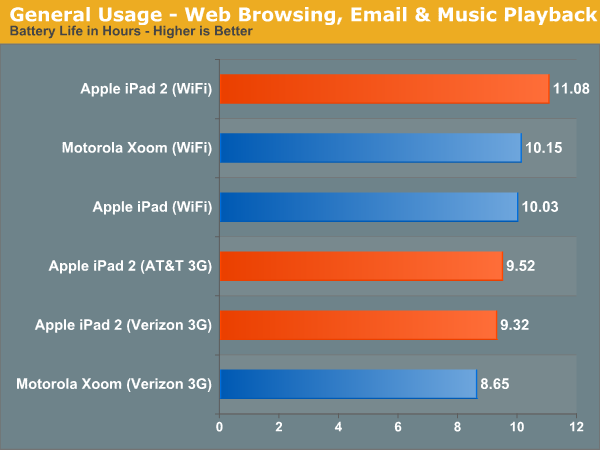The Apple iPad 2 Review
by Brian Klug, Anand Lal Shimpi & Vivek Gowri on March 19, 2011 8:01 PM ESTBattery Life
Testing battery life on a tablet is pretty grueling as these things are effectively smartphones with gigantic batteries. What would last for only a few hours on a smartphone can easily last over ten on a tablet. The iPad 2 is no exception.
As iFixit discovered, the iPad 2 features a nearly identical battery to the original iPad (25Wh vs. 24.8Wh). We already established that display brightness hasn't gone up so the only real impact on battery life will be because of the A5 SoC.

The iPad 2 WiFi's battery, courtesy iFixit
The ARM Cortex A9 tends to be more power efficient than its predecessor, the A8. With a shallower pipeline and the ability to execute instructions out of program order you get better performance per watt in most cases. As a result the A5 should complete bursts of instructions quicker than the A4 and get back to sleep sooner.
To put this to the test we put together a battery life test that combined our non-Flash smartphone web browsing test, checking for email every 15 minutes (via a Gmail account receiving ~100 emails per day) and constant local music playback while all of this is going on. The results are pretty much as expected:

Over WiFi the Motorola Xoom and iPad 1 deliver very similar results. The iPad 2 pulls ahead by around 8%, it's not a huge advantage but it's there. Over 3G there's a noticeable drop in battery life, putting both of the iPad 2s below 10 hours and kicking the Xoom down to under 9 hours. All of the numbers on this chart are respectable however and you can expect a good day's worth of use out of any of these tablets.
Note that while the iPad 2 did better than its predecessor if you were to run an app that pegged both CPU cores at 100% you'd see reduced battery life on the iPad 2 vs. the iPad 1. Granted you'd also see better performance on the iPad 2.
Video playback is obviously an important function of these new tablets so we put together a H.264 decode playback test as well. For this test we transcoded a copy of Quantum of Solace from a 1080p BD source down to a 720p H.264 using Handbrake's Normal encode profile with one modification. In order to enable smooth playback on the Motorola Xoom we had to disable b-frames in the encode. The results are below:

The iPad 2 consistently lasted longer than the original iPad in our video playback test. The Xoom however did noticeably worse. Unfortunately only a portion of the H.264 decode pipeline is accelerated by NVIDIA's Tegra 2 in this test. When playing back anything more strenuous, portions of the pipeline are handled by the CPU cores in software. If you were to enable b-frames the Xoom would not only stutter but its battery life would drop to around 6 hours.
On the iPad 2 its Cortex A9s are mostly powered down during this test, on the Xoom the A9s are helping with the heavy lifting for video decode and as a result we see lower battery life. Kal-El is expected to address this issue head on.










189 Comments
View All Comments
TareX - Sunday, March 20, 2011 - link
Irrelevant, but is Anandtech gonna do an Atrix review?name99 - Sunday, March 20, 2011 - link
"The Digital AV adapter is a bit clunky and I believe the future of this is clearly in some form of wireless transmission, but for now it plugs directly into the dock connector. "You mean the wireless transmission that ALREADY EXISTS called AirPlay?
Apple HAVE a solution to your hatred of wires. You seem to be upset that they don't have a solution that somehow magically transports video from iPad to your (HDMI and nothing else) TV using some non-existent wireless standard that isn't actually built into your TV.
It's fine to be frustrated at some of the idiocies in tech, but it's truly silly to complain about this one. Apple provides this cable for one, and only one, group of users --- people who actually NEED that physical wire.
BlendMe - Sunday, March 20, 2011 - link
AirPlay doesn't mirror tha iPads screen, it only allows you to stream content. For now. And for AirPlay you need an Apple TV or another AirPlay enabled device. The HDMI adapter allows you to hook it up to almost any recent TV, monitor or beamer.ananduser - Sunday, March 20, 2011 - link
In fact there is a standard already built in in most modern(emphasis on modern) TVs. It is called DLNA. Unfortunately Apple decided that coercing you into using their ecosystem ONLY is the way to go. Personally I find Apple's modus operandi of not giving 2 sh*ts about other 3rd party solutions one of the "idiocies in tech" as you well put it.Regardless, the iPad2(or 1) is a cool gadget(emphasis on gadget) nonetheless. Combined with leading parental controls as:no flash(as a porn enabler), no porn(appstore policy), no bloody/gory games(appstore policy) and a damn spartan simple and fast GUI makes it a great basic computing device for the naive crowd(parents, grandparents etc.). IMO it really shines for children as their 1st computing platform.
That it is also a frequent choice for the tech literate few, good on them... it still is best suited, IMO, for those of the above.
name99 - Sunday, March 20, 2011 - link
Can both of you not read?I was referring to, as I quoted, "The Digital AV adapter is a bit clunky and I believe the future of this is clearly in some form of wireless transmission, but for now it plugs directly into the dock connector. "
How do either of your comments have any relevance to that?
If you want Wifi, you need something that accepts a Wifi signal. Your TV doesn't have Wifi built in, so, yeah, you need some other box.
And DLNA? Really? You want to go there? Go explore the DLNA web pages (http://www.dlna.org/products is a good start) and tell me this pile of turds is EVER going to be relevant to the real world. For god's sake, man, get in touch with the real world. Compare that web page and everything it implies about compatibility nightmares and technobabble with the Apple TV web page.
Anand Lal Shimpi - Monday, March 21, 2011 - link
AirPlay is really for specific content at this point. I'm referring to the future of video out on tablets in general. And I didn't mention it as a knock against the iPad today, just a heads up that in some future version of the iPad you won't need a physical adapter (at least not on your tablet). When you have full wireless display mirroring then you can start introducing more interesting usage models - e.g. tablet as a desktop replacement, tablet as a game console, etc... You can do these things without wireless display but they are definitely enhanced by it being there.Take care,
Anand
Ushio01 - Sunday, March 20, 2011 - link
When ifixit did there teardown of the first ipad it was shown that apart from the battery and the antennas all the other components were kept up the top so why can't a tablet simply be a dock you slot a smartphone in that supplies a larger screen and additional battery's?That to me is a far more appealing device than current tablets.
kmmatney - Monday, March 21, 2011 - link
makes sense to me. I can't see Apple doing this, but maybe on of the Android makers can come up with something along these lines. I'd love to be able to pop my phone into the back of a tablet and use the bigger screen. I'd just keep it near the couch.zmatt - Sunday, March 20, 2011 - link
I still hold that the entire market segment (not just the iPad) is a solution looking for a problem. The idea seems cool but in reality nobody was asking for the tablet. And after using them I still can't see what the attractiveness is other than people buying them cause they are "cool". I take calls and get mobile updates on my Galaxy S, which is more than competent enough for light work such as taking down notes or answering emails on the go. Any real work I do with a computer. I'm sorry but you can't make up for the lack of performance and a real keyboard if you are talking about getting work done. The iPad may be nice for mobile entertainment, but if i already have an mp3 player and a laptop what can it do that they can't? For tablets to be viable productivity devices and not just toys i think they would basically have to evolve into laptops. So again i ask, what's the point?cucurigu - Sunday, March 20, 2011 - link
Thanks a lot for your review, Anand, Brian and Vivek - I was waiting for your opinion on the iPad 2 as it was a gadget most appealing but, as you said, very polarizing for the reviewers.There is something I didn't really understand, even after rereading the Xoom review - both you (Anand and Brian) said the first iPad wasn't your cup of tea in the long run and chances are the new one won't change this (but you're giving it another go). The general impression (one which I also got while looking at the tablet segment) is characterized by their unclear niche - where do they really fit ?
If I understand correctly the first tablet (ipad) didn't integrate with your workflow and the reasons seem to apply to all tablets, however, this sentiment doesn't come off so clearly from the Xoom article - so I wondered : did you have the impression the Android OS was more adequate to your usage patterns ? Meaning, if the Xoom and iPad 2 where left on your desk, which one would you choose to take with you, and for which purpose ?
Once again, thanks and best regards !